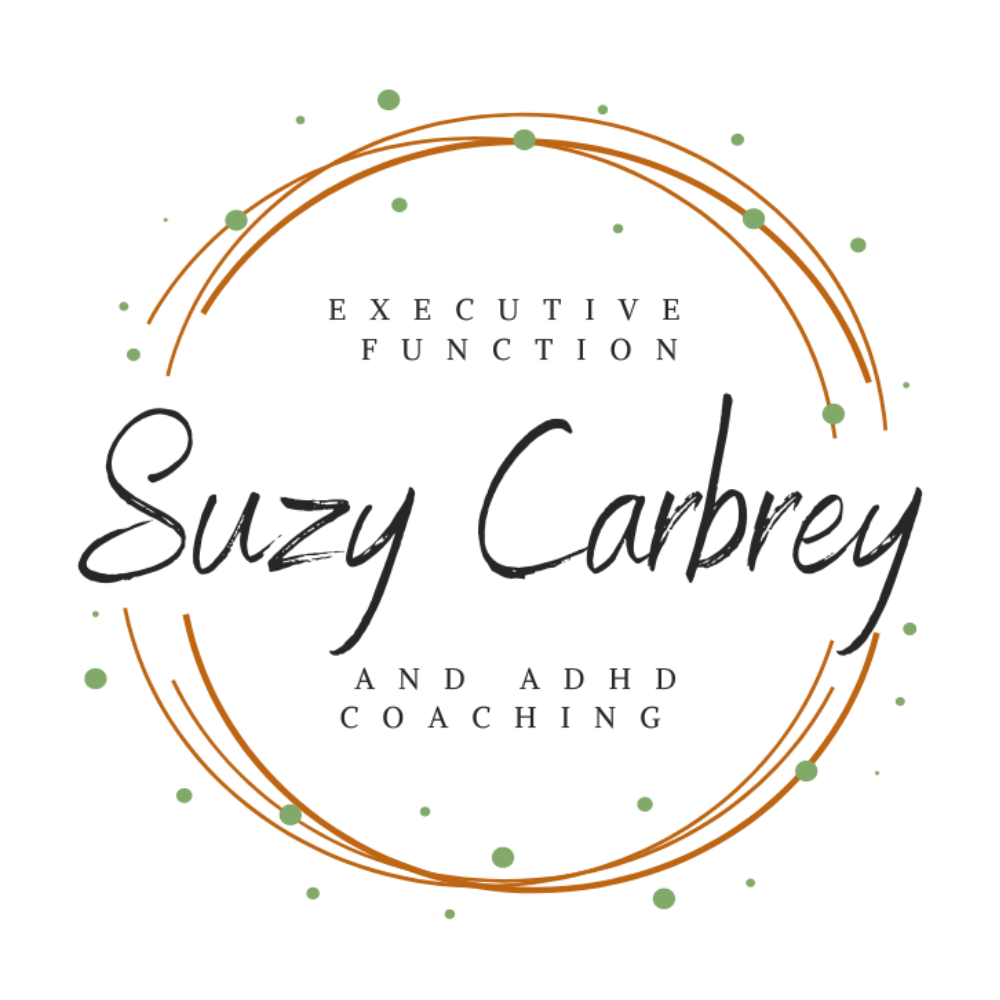Let’s talk about how to choose one change to focus on and actually follow through. This post will guide you through:
- Understanding the “everything sounds helpful” trap
- The importance of supportive constraints
- How to use curiosity (instead of pressure)
- A step-by-step process for choosing and committing to one change
- What to do when your plan starts to wobble
The “Everything Sounds Helpful” Trap
For people with executive functioning challenges, prioritization can feel like an impossible task. All the ideas seem equally important, equally urgent, and equally motivating—for a moment.

Part of the problem is that helpful strategies often get framed as shoulds:
- You should wake up earlier.
- You should drink more water.
- You should meditate, declutter, meal prep, budget, stretch, journal, and track your habits.
But when everything is a “should,” nothing gets done. Executive overload kicks in. And with ADHD or related challenges, motivation is often fueled by novelty. That means the idea of the change can be more rewarding than the follow-through.
This is where supportive constraints come in.
Why We Get Stuck in the Planning Stage
Sometimes, the hardest part of making a change is picking where to start. For many adults with executive functioning challenges, this isn’t about laziness or lack of motivation, it’s about getting caught in a swirl of competing priorities, perfectionism, or pressure to get it right the first time.
Planning can feel productive, like something is happening. But without action, planning becomes a kind of procrastination loop. We scroll through ideas, download templates, or create color-coded systems without ever settling into one thing.
Part of this is because novelty is exciting. Our brains light up when we imagine the potential of each new approach. But novelty fades quickly, and without clarity or follow-through, we end up right back where we started.
The shift begins with acknowledging that clarity comes from action, not the other way around. Instead of waiting to find the perfect change to make, we can choose one small step and let that be enough for now. It’s not a lifetime commitment. It’s an experiment, and experiments are how we learn.
Try asking:
- “If I had to pick just one thing to try this week, what would feel meaningful and doable?”
- “Which idea feels like it would teach me something about myself, even if it’s not perfect?”
These questions invite progress, not perfection.
Supportive Constraints: Freedom Through Limits
It might sound counterintuitive, but limits can actually make it easier to move forward. We call them supportive constraints, boundaries that narrow your focus in a way that feels kind, not controlling.
Here are a few supportive constraints that can help:
- One change at a time. Not forever, just for now.
- One area of life. (e.g., routines, organization, relationships)
- One small version. (Instead of “exercise more,” try “walk 10 minutes twice a week.”)
- One decision-making filter. (e.g., “What’s the change I’d most feel the impact of this week?”)

Supportive constraints give you something to push against—in a good way. They help you build momentum without having to carry the entire mountain.
Replace Pressure with Curiosity
If you find yourself saying things like:
- “I should be able to do this by now.”
- “Why can’t I just stick to it?”
- “Everyone else seems to have this figured out.”
That’s pressure talking.
Pressure tends to trigger shame or perfectionism. And when the brain feels shamed, it doesn’t want to grow, it wants to retreat.
Curiosity, on the other hand, is expansive. It sounds like:
- “What’s going on here?”
- “What’s working and what isn’t?”
- “What do I actually need right now?”
When you use curiosity, you’re creating a growth-supportive environment for your brain—one where you can make informed, compassionate decisions.
Expect to Restart (and Talk to Yourself Kindly)
Even a small task can feel enormous if it’s emotionally charged. Perfectionism, fear of failure, frustration, or shame can make a simple action feel unsafe, as if there’s danger in the doing.
This might show up as:
- Avoiding a task because you’re afraid of doing it “wrong.”
- Feeling overwhelmed by big emotions before, during, or after starting.
- Trying to “white-knuckle” your way through and burning out
👉 Try this: Use compassionate self-talk to create safety. Instead of “What’s wrong with me?” ask, “What emotion might be getting in the way?” Try reframing the task: “This is a little hard for me, and that’s okay. I can do hard things in small steps.”
Step-by-Step: Choosing and Committing to One Change
Step 1: Pause and Brain Dump
Set a timer for 5–10 minutes. Write down all the things you feel like you should be doing. Don’t edit or organize, just get it out. This can include habits, routines, goals, to-dos, or even vague desires like “get my life together.”
Seeing everything in one place helps relieve mental clutter and gives you something concrete to work with.
Step 2: Sort and Group
Look over your list and group similar items together. You might notice themes like:
- Energy and health (sleep, hydration, movement)
- Organization (planners, calendars, decluttering)
- Routines (morning, bedtime, transitions)
- Emotional regulation (self-talk, mindfulness, rest)
- Productivity (prioritization, focus tools)
This step brings order to the chaos and helps your brain process categories instead of one overwhelming jumble.

Step 3: Ask Guiding Questions
Now get curious. Not pressured—just curious.
Ask yourself:
- Which of these would make the biggest difference in my day-to-day life?
- What’s bothering me the most right now?
- What’s one area where I’m ready, or almost ready, to try something different?
- If I could wave a magic wand and have one of these things solved, which would I choose?
There are no wrong answers. This is about listening inward instead of reacting outward.

Step 4: Choose One Change to Test
Notice that word: test. You’re not making a permanent commitment. You’re experimenting with one change for the next 1–2 weeks.
Make it specific and bite-sized. Use this format:
I’m going to [action] for [duration] to see how it feels.
Examples:
- “I’m going to set a 2-minute timer each night to put away the dishes for one week.”
- “I’m going to check my calendar every morning for 5 days and note 1 priority.”
- “I’m going to do a 30-second stretch before bed for the next 7 days.”
This mindset keeps you focused, reduces overwhelm, and lowers the pressure for perfection.
Step 5: Create a Simple Visual Cue
Don’t rely on memory or motivation. Use external supports.
Visual cues might include:
- A sticky note on your bathroom mirror
- A calendar checkbox or tracker
- A recurring phone reminder
- Pairing the task with an existing habit (habit stacking)
Externalizing your intention helps bridge the gap between idea and action.
When Things Start to Wobble (Because They Will)
Even with the best intentions, you’ll likely miss a day. Maybe a few. That’s normal.
The key is to avoid all-or-nothing thinking. One skipped action doesn’t mean failure. Try one of these reframes:
- “This is part of the process, not the end of it.”
- “I’m still learning what works for me.”
- “What got in the way, and what might help next time?”

You can also practice a “soft restart.” No guilt. No punishment. Just a gentle return to your plan.
Pro tip: Use a reflection question at the end of the week like,
“Did this feel helpful?”
or
“What do I want to keep, tweak, or let go of?”
It’s Okay to Want All the Changes
Of course, you want to feel better, function better, and live more smoothly. That desire makes sense.
But real change happens through small, consistent focus, not scattered sprints.
You don’t need to “do it all.” You just need to pick one thing, try it with compassion and curiosity, and let yourself build trust in your own follow-through.
One change can lead to another—and another—and another. Not because you forced it, but because you practiced it.
Learn more with Online Coaching for Executive Functioning / ADHD
Ready to gain control and enhance your executive functioning? As an experienced and compassionate coach, I specialize in providing support for executive functioning and ADHD. To embark on your journey, please reach out to me at 708-264-2899 or email hello@suzycarbrey.com to schedule a FREE 20-minute discovery call consultation.
With a background as a speech-language pathologist, I have a strong foundation in executive functioning coaching. My graduate degree program in SLP placed a significant emphasis on cognition, including executive functions, and I have years of experience in medical rehabilitation, providing cognitive-communication therapy. Additionally, I have completed an ADHD Services Provider certification program, I am Solutions-Focused Brief Therapy Diamond Level 1 certified and I am trained in the Seeing My Time® executive functioning curriculum.
Experience the convenience and effectiveness of online coaching, backed by studies that demonstrate equal results to in-person services. Parents, professionals, and emerging adults love the convenience and privacy of receiving coaching from their own homes.
Whether you reside in Chicago, Milwaukee, Indianapolis, Kansas City, or anywhere else around the globe, I am here to assist you. Schedule your discovery call consultation today, and I eagerly anticipate the opportunity to work with you!
Please note that although I am a certified speech-language pathologist, all services Suzy Carbrey LLC provides are strictly coaching and do not involve clinical evaluation or treatment services. If you require a formal speech therapy evaluation and treatment, please inform me, and I can provide appropriate recommendations.


